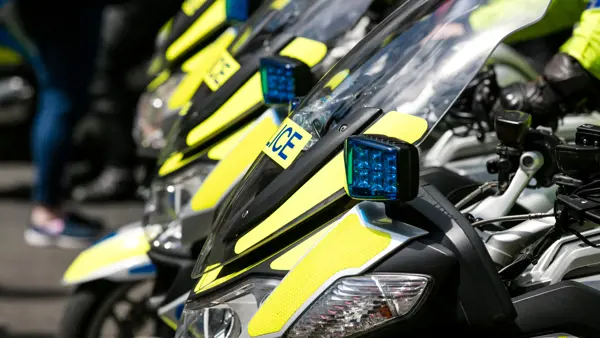Table of Contents
Microsoft Technology for Police Forces
Prevent and reduce the fear of crime, and improve the quality of life for all members of the public with Microsoft technology.


Arrested Development: Why it’s time for police forces to look again at ERP
British policing is rapidly approaching the two-hundredth anniversary of the establishment of the Peelian Principles. First set down in 1829 to underpin the model of “policing by consent”, they remain the standard by which the force is recognised, admired – and judged - throughout the world. There are now 43 territorial and 3 specialist forces serving England and Wales, together with national organisations in Scotland and Northern Ireland working tirelessly to maintain order, tackle crime and keep the UK secure.
Today’s forces face a unique set of challenges, with shifting responsibilities, new priorities, and an ever-present need to support society within the restrictions of budget control. Furthermore, as society changes, so must policing, and fast. We’re living our lives increasingly online, and this has created a need for policing to become more digitally enabled.
In recognition of this, the National Policing Digital Strategy (1) outlined a broad range of aims and ambitions. Looking to the future, the strategy explores ways in which to harness new technologies to deliver a police service able to answer the questions being asked of it, such as:
This whitepaper – the first in a series of four – will explore some of the benefits that new technology can unleash. It will look at barriers to change, and at ways in which they can be overcome. It will explore the latest developments in ERP – Enterprise Resource Planning – demonstrating why now is the time for forces across the country to look again at how the deployment of ERP platforms can help drive organisational change, enabling optimal management of resources and unlocking efficiencies on a before unimaginable scale.
The police service stands on the brink of change. By making the right digital choices, forces across the country can swiftly adapt to meet the changing nature of crime as society evolves. Streamlining operations at all levels, lifting administrative burdens, freeing up the frontline and ultimately reducing criminality through a force in which the public can be rightly confident. Questions already? Get in touch with our experts to see how we can support you.
Table of Contents
Arrested Development: Why it’s time for police forces to look again at ERP
Keeping Pace with Change
3Putting the data mountain to work
4Enterprise Resource Planning
5ERP at the departmental level
6HSO and Microsoft Dynamics 365


Keeping Pace with Change
Sir Michael Barber, Chair, The Strategic Review of Policing in England and Wales says:
"Policing in this country is at a crossroads and it cannot stand still whilst the world changes so quickly around it. Now is the moment to move forward quickly on the path of reform. The warning signs if we do nothing are flashing red and we ignore them at our peril." (2)
On the evening of January 1st, 1845, a man named John Tawell boarded the 19:42 service from Slough to London. He was fleeing the scene of a murder, and as his train eased away from the platform, he must have thought he had got away with it. In another location, he might have. Slough, however, was equipped with telegraph, then state-of-the-art in communications technology. A pursuing witness gave a clear description to the police and officers were able to send a message along the wire to Paddington. Tawell was followed through the capital’s streets and apprehended. Later prosecuted, he became the first man ever to be arrested through the use of technology. (3)
Technology is no less relevant to police work today. Revolutionising both frontline and backoffice procedures through the adoption of such innovations as Artificial Intelligence (AI), Robotic Process Automation (RPA), Machine Learning (ML) and cloud computing. However, many forces have only scratched the surface. For many reasons, both real and perceived, the potential of digitalisation is not yet fully realised.
Though there is a genuine desire for improvement, some forces have experienced problems with interoperability. Integration with legacy technology has been a source of difficulty, with some systems unable to work across platforms. Formerly known as the Met Integrated Policing Solution (MiPs), the CONNECT programme designed to enable connectivity between the Metropolitan Police Service’s disparate systems has been subject to several delays and cost increases. (4)
The country’s largest force has 17 different systems which are unable to connect with each other, such as communications and control, crime reporting, missing persons etc. This leads to duplication in data-inputting, placing a drain on officers’ valuable time. Problems such as this are replicated at forces throughout the country. Speaking at a TechUK event, Phil Baxter, ERP Programme Director at Avon and Somerset Police highlighted some of the difficulties, saying, “There are duplicate processes. There’s repetitive data entry…” “…Even a question as simple as ‘How many people do we have working where and who’s paying for them?’ throws up a handful of answers when there should be just one. In fact, a recent task force had to be established to determine how many people we had working for us, and where.” (5)
The lack of a national standard data model has led to issues with cross-force collaboration and where multi-force solutions have been put in place, the goals being pursued have not always been mutually agreed. Decisions are often made without a full understanding of the desired outcome. Substantial investments have been made into projects that have failed to deliver, further bolstering resistance to change.


The Role of Technology in Modern Policing
Challenges and Opportunities, with Harvy Rai MBE, Police Sergeant, West Midlands Police. In this podcast we discuss:
✔ The challenges of cross-border policing
✔ The role of technology and data in creating consistent policing
✔ Why developing the right partnerships is key to improving policing
"We are wasting time and money and inefficiencies on our current platform, and most importantly the processes that the platform enables or doesn’t enable."
The National Policing Digital Strategy (7) states: "Policing does not operate in a vacuum and cannot stand still in the increasingly digital world we work and live in. The challenges and opportunities that digital disruption presents to policing are rapidly becoming defining issues for the service. We must move now and move quickly.”
According to Chief Superintendent Simon Ovens, DL FCMI, Head of Traffic and Transport Policing at the Met, speed of rollout can present difficulties. By the time solutions are implemented, they are often out of date and in need of upgrades. There are also training implications. Unlike the armed forces, whose members spend much of their time training, police officers must be taken off duty to learn how to work with new systems. Ease of use is a vital consideration. Policing is going through a rapid period of change.
The demands placed on the force of today are a world apart from those of just a generation ago. Our “always connected” culture has given rise to a different type of crime. Forty per cent of crime is now fraud (8), much of which is “Policing does not operate in a vacuum and cannot stand still in the increasingly digital world we work and live in. The challenges and opportunities that digital disruption presents to policing are rapidly becoming defining issues for the service. We must move now and move quickly.*” National Policing Digital Strategy online.
Figures from the National Cyber Security Centre show a significant rise in cybercrime (9), which is often investigated at the force level. Wider social problems are also a distraction, with the police often having to step in to fill gaps for other agencies. Dealing with the consequences of mental health issues, for example, takes up a lot of time, and officers often spend hours of their shifts waiting in hospitals.
Another shocking statistic is the three million investigation hours a year that is spent following up on missing person inquiries (10) – the equivalent of policing the North Yorkshire Constabulary area for a year. With such clear evidence of the need for effective time management, the necessity for force-wide resource planning is made apparent.
The response to these shifting responsibilities necessitates a reduction in community policing. Consequently, detection rates are low. In the year to March 2022, just 5.6% of offences resulted in a charge and/or summons. (11) In something of a vicious circle, this lack of visibility may be contributing to falling public confidence (12), a vital cornerstone of the “policing by consent” ethos so essential to the British force. Police leaders understand the problems well.
Increasing caseloads must be tackled with fewer resources. Though Home Office statistics in early 2023 showed an annual uplift of 2.3% in officer numbers (13), the increase required significant attendant work to ensure new applicants were properly vetted and onboarded. Resource management is an onerous task for all forces.
The challenges extend beyond the front line, the public face of policing. For any law enforcement agency, back office or support processes are an equally essential component in providing an effective service. Specialist investigations, intelligence and analysis, communications and scientific/technical staff face many of the same pressures, as do those working in business and management functions: finance and services, HR and ICT. They, too, must react to accelerating societal change, a constantly evolving legislative environment and the accumulation of greater quantities of data than the legacy IT estate was ever designed to handle.


Putting the data mountain to work
Data is being gathered at a growing rate. Every interaction with the public creates a record, as do staff movements, financial transactions and all manner of everyday business activities. Over time, each force has built its own internal system of records. The IT infrastructure is often outdated, with limitations in terms of interoperability, capacity and usability. In addition to these, access to information held on national databases and those of partner agencies such as the health and care services is often required.
While this has presented a burden traditionally, for a digitally mature service this vast store of data becomes the fuel to power new technologies, enabling forces to meet the challenge of changing demand. By unlocking the hidden power of data, and enabling cross-silo access which has previously presented a barrier to collaboration, forces are able to streamline their processes. Properly managed, data helps meet the myriad sophisticated demands placed on every modern police force, increasing efficiency and helping inform strategic decision-making.
The Government is very clear in its ambitions to pursue digitalisation across the whole of the public sector. In the far-reaching Cabinet Office Report, Organising for Digital Delivery (14), the systemic frailties present in obsolete IT infrastructure were highlighted. The cost of maintaining the public sector IT estate is immense, with the report estimating a figure of between £13 and £22 billion for the five years to 2025.
Transforming for a digital future: 2022 to 2025 roadmap for digital and data (15).
Set out a series of actions to enable digital transformation across the public sector as a whole, enabling teams to work smarter, streamlining processes and reducing duplication. Acknowledging that the path to digitalisation has not always run smoothly, the roadmap aimed to ensure that mistakes made in the past were not repeated, instead presenting a learning opportunity upon which to build.
In order to answer the questions being asked of policing in the twenty-first century, it is evident that change is both inevitable and essential. Crucially, it should not be a top-down, one-size-fits-all solution. Instead, the process should be one of continuous innovation, an evolution that allows each force, team and department to tailor its response, allowing a culture of change to flourish within the organisation.
To move forward, leaders and teams must take a holistic approach, recognising and understanding the need for change at an enterprise level. There is an urgent need to demystify ERP technology. It should not be seen as an IT project but as an enabler of change throughout the entire organisation.
"I also want to see better and more consistent data, which underpins a joined-up approach to local crime-fighting activity. I am overseeing new central guidance on data-sharing, as well as bringing together local-level examples of good practice, to help build a more data-confident culture. I also want to see more data transparency to drive up standards across policing" (16)


Enterprise Resource Planning
Paul Willmott, Executive Chair, Central Digital and Data Office says:
“Digital and data are the essential building blocks of all successful organisations. It’s only possible to make effective decisions, meet customer needs and respond to new challenges and opportunities when you have modern technology, real-time access to high-quality data, a cadre of skilled digital talent and the right conditions for innovation to thrive.” (17)
As the economy continues to suffer the fallout of inflationary pressures, worldwide energy supply issues and the effects of war on the European continent, the public sector is facing a need to find further efficiencies. Announced by the Chancellor of the Exchequer, a savings and efficiency review will “target increased efficiency, Reprioritise spending away from lower-value programmes, and review the effectiveness of public bodies.” (18)
In England and Wales, responsibility for policing falls to the Home Office, in Scotland and Northern Ireland, the respective Government and Assembly. The police are not immune to the review’s aims.
Across the whole of the UK, forces must remain effective even under straitened economic conditions.
Though the challenges facing police forces are great, they also present opportunity. ERP platforms, such as Microsoft Dynamics 365, provide a robust framework in which multiple disparate systems can operate. Deploying an ERP platform should no longer be viewed as a technological Big Bang, necessitating large investments with wholesale changes to the existing IT infrastructure. Agile and efficient, a modern ERP system works with the existing technology, evolving iteratively to meet the changing needs of an organisation.
By building connections throughout the entire organisation and beyond, partner agencies can be included where a requirement is present, such as a need for data sharing between police and social services or health and care providers.
ERP provides access to previously siloed data to enable greater collaboration between teams, meeting the rapidly changing requirements highlighted earlier, and delivering efficiencies throughout the entire organisation.


Listen to episode 1, How technology and digital transformation is impacting operational policing, from our four-part podcast series
In this podcast, we discuss How modern ERP strategies impact and enable smart policing across the UK with Greater Manchester Police and MET Police.
In contrast to earlier iterations, the latest innovations ensure that today’s ERP solutions are interoperable with existing technology, working efficiently alongside current infrastructure. Modern ERP solutions are easily deployable and scalable, meeting the shifting operational needs of today’s police services.
In contrast to earlier iterations, the latest innovations ensure that today’s ERP solutions are interoperable with existing technology, working efficiently alongside current infrastructure.
Modern ERP solutions are easily deployable and scalable, meeting the shifting operational needs of today’s police services. Allowing a seamless flow of data throughout the organisation, ERP links multiple systems on one platform, ensuring all needs are met and helping deliver an agile, efficient response across preexisting divisions.
Joined-up services are enabled, streamlining provision and allowing more effective deployment of resources. Staff are freed up to concentrate on higher-value tasks, both in terms of operational significance and – crucially – public perception, with officers able to become more visible and provide improved frontline services across communities.


ERP at the departmental level
A modern police force is comparable to a large business in terms of the need to manage complex finances. To remain effective, the flow of funds must be managed and tracked, enabling informed planning and ensuring service provision remains in place. ERP solutions help streamline accounting processes, integrating data to provide a real-time, all-round vision of the force's financial position. By centralising operations around a single platform, spending can be carefully controlled and cost efficiencies facilitated. Duplication is eliminated and human error minimised.
Resourcing is a cumbersome task in policing, with a definite need for automation. The Metropolitan Police currently outsources the Human Capital Management process as part of a wider business support services contract (20) but the need to manage staff places a heavy demand on all forces. A modern ERP solution can accomplish many traditional HR tasks, from recruitment, payroll and staff absence management to onboarding and career development.
Connecting databases, the centralised platform enables cross-silo access to information to provide a single viewpoint. Staff data can be instantly accessed. Employee performance can be monitored and tracked, helping to identify training needs and intelligently plan deployments. Vetting procedures are simplified and can be handled expeditiously.
As with any other public sector organisation, careful supply chain management is a critical requirement for the police.
An ERP system allows every department access to the same information in real-time. All relevant data is readily available, avoiding the need for duplication of entry and minimising the chance of error.
The procurement process is accelerated, improving productivity and freeing staff to concentrate on more value-added tasks. Once again, integrating data visibility is enhanced, efficiency improved and the potential for automation created.
In the National Policing Digital Strategy, the need to provide citizens with greater access to services was acknowledged.
“We will deliver seamless, digitally enabled experiences. The public will have more choice in how they engage with us, using channels, media or devices most relevant to them. We will be able to connect citizen interactions, information and data across departments, and across forces to build a more credible and richer intelligence picture, all whilst maintaining public trust by ethically acquiring, exploiting and sharing their data.” (21)
ERP can help deliver this ambition. A single, centralised platform can offer immediate access to data through a multiplicity of devices from almost anywhere. For frontline officers, the time taken to record information and access to all appropriate databases will be reduced, duplication and the potential for error will be minimised while members of the public will have the ability to contact the police swiftly and accurately when needed.
“Cops will approach problems in the same way over and over again. If there’s ever a role for technology, it is to approach things differently.”



HSO and Microsoft Dynamics 365
As a Microsoft Solutions Partner, HSO has built a first-class reputation for delivering business transformation programmes over more than 35 years. Using the full power of Microsoft’s technology, HSO works with organisations to develop systems that connect and communicate to improve operational efficiency. By choosing HSO, organisations have access to the very latest Microsoft technology, tailored to fit their exact requirements while minimising ongoing costs.
Microsoft Dynamics 365 is uniquely able to meet the changing needs of the modern British police. Implemented at a scale and pace to suit organisational requirements, it works alongside the existing IT estate to enable seamless data sharing, promoting collaboration throughout the entire organisation.
The platform can be deployed iteratively, enabling proof-of-concept trial without the need for wholesale replacement of legacy systems until the time is right.
By enabling the integration of data, Microsoft Dynamics 365 ERP opens up a world of possibility in policing. No longer restricted by data silos, process automation can be implemented across numerous back-office functions, giving time back to the workforce. More effective data analysis is enabled, helping to build a comprehensive
intelligence picture. Staff can be deployed more effectively, placing officers where they are needed when they are needed. From the back office to the frontline, a process of continuous improvement is embedded, delivering operational benefits throughout the organisation.
Implemented at a scale appropriate to organisational needs and budgets, ERP has the power to deliver both quick wins and wider strategic benefits. Once again, policing stands on the cusp of a technological revolution. The potential for organisational change is huge.
With the right digital partner by their side, police forces throughout the UK can meet the challenge of the changing nature of crime, put more officers back on the beat, increase prosecution rates and, ultimately, provide a service in which the public can be rightly confident.
ERP solutions enable streamlined data flows across all business areas





Blog and Podcast from this series
Read our blog and listen to our podcast from this series below

Microsoft Technology for Police Forces
Prevent and reduce the fear of crime, and improve the quality of life for all members of the public with Microsoft technology.


HSO by the numbers: our history is our strength
We, and third parties, use cookies on our website. We use cookies to keep statistics, to save your preferences, but also for marketing purposes (for example, tailoring advertisements). By clicking on 'Settings' you can read more about our cookies and adjust your preferences. By clicking 'Accept all', you agree to the use of all cookies as described in our privacy and cookie policy.
Purpose
This cookie is used to store your preferences regarding cookies. The history is stored in your local storage.
Cookies
Location of Processing
European Union
Technologies Used
Cookies
Expiration date
1 year
Why required?
Required web technologies and cookies make our website technically accessible to and usable for you. This applies to essential base functionalities such as navigation on the website, correct display in your internet browser or requesting your consent. Without these web technologies and cookies our website does not work.
Purpose
These cookies are stored to keep you logged into the website.
Cookies
Location of Processing
European Union
Technologies Used
Cookies
Expiration date
1 year
Why required?
Required web technologies and cookies make our website technically accessible to and usable for you. This applies to essential base functionalities such as navigation on the website, correct display in your internet browser or requesting your consent. Without these web technologies and cookies our website does not work.
Purpose
This cookie is used to submit forms to us in a safe way.
Cookies
Location of Processing
European Union
Technologies Used
Cookies
Expiration date
1 year
Why required?
Required web technologies and cookies make our website technically accessible to and usable for you. This applies to essential base functionalities such as navigation on the website, correct display in your internet browser or requesting your consent. Without these web technologies and cookies our website does not work.
Purpose
This service provided by Google is used to load specific tags (or trackers) based on your preferences and location.
Why required?
This web technology enables us to insert tags based on your preferences. It is required but adheres to your settings and will not load any tags if you do not consent to them.
Purpose
This cookie is used to store your preferences regarding language.
Cookies
Why required?
We use your browser language to determine which language to show on our website. When you change the default language, this cookie makes sure your language preference is persistent.
Purpose
This service is used to track anonymized analytics on the HSO.com application. We find it very important that your privacy is protected. Therefore, we collect and store this data anonymously on our own servers. This cookie helps us collect data from HSO.com so that we can improve the website. Examples of this are: it allows us to track engagement by page, measuring various events like scroll-depth, time on page and clicks.
Cookie
Purpose
With your consent, this website will load Google Analytics to track behavior across the site.
Cookies
Purpose
With your consent, this website will load the Google Advertising tag which enables HSO to report user activity from HSO.com to Google. This enables HSO to track conversions and create remarketing lists based on user activity on HSO.com.
Possible cookies
Please refer to the below page for an updated view of all possible cookies that the Google Ads tag may set.
Cookie information for Google's ad products (safety.google)
Technologies Used
Cookies
Purpose
With your consent, we use IPGeoLocation to retrieve a country code based on your IP address. We use this service to be able to trigger the right web technologies for the right people.
Purpose
With your consent, we use Leadfeeder to identify companies by their IP-addresses. Leadfeeder automatically filters out all users visiting from residential IP addresses and ISPs. All visit data is aggregated on the company level.
Cookies
Purpose
With your consent, this website will load the LinkedIn Insights tag which enables us to see analytical data on website performance, allows us to build audiences, and use retargeting as an advertising technique. Learn more about LinkedIn cookies here.
Cookies
Purpose
With your consent, this website will load the Microsoft Advertising Universal Event Tracking tag which enables HSO to report user activity from HSO.com to Microsoft Advertising. HSO can then create conversion goals to specify which subset of user actions on the website qualify to be counted as conversions. Similarly, HSO can create remarketing lists based on user activity on HSO.com and Microsoft Advertising matches the list definitions with UET logged user activity to put users into those lists.
Cookies
Technologies Used
Cookies
Purpose
With your consent, this website will load the Microsoft Dynamics 365 Marketing tag which enables HSO to score leads based on your level of interaction with the website. The cookie contains no personal information, but does uniquely identify a specific browser on a specific machine. Learn more about Microsoft Dynamics 365 Marketing cookies here.
Cookies
Technologies Used
Cookies
Purpose
With your consent, we use Spotler to measures more extensive recurring website visits based on IP address and draw up a profile of a visitor.
Cookies
Purpose
With your consent, this website will show videos embedded from Vimeo.
Technologies Used
Cookies
Purpose
With your consent, this website will show videos embedded from Youtube.
Cookies
Technologies Used
Cookies
Purpose
With your consent, this website will load the Meta-pixel tag which enables us to see analytical data on website performance, allows us to build audiences, and use retargeting as an advertising technique through platforms owned by Meta, like Facebook and Instagram. Learn more about Facebook cookies here. You can adjust how ads work for you on Facebook here.
Cookies
Purpose
With your consent, we use LeadInfo to identify companies by their IP-addresses. LeadInfo automatically filters out all users visiting from residential IP addresses and ISPs. These cookies are not shared with third parties under any circumstances.
Cookies
Purpose
With your consent, we use TechTarget to identify companies by their IP address(es).
Cookies
Purpose
With your consent, we use this service provided by uMarketingSuite to run A/B tests across the HSO.com application. A/B testing (also called split testing) is comparing two versions of a web page to learn how we can improve your experience.
Purpose
With your consent, we use this service provided by uMarketingSuite to personalize pages and content across the HSO.com application. Personalization helps us to tailor the website to your specific needs, aiming to improve your experience on HSO.com.
Purpose
With your consent, we use ZoomInfo to identify companies by their IP addresses. The data collected helps us understand which companies are visiting our website, enabling us to target sales and marketing efforts more effectively.
Cookies